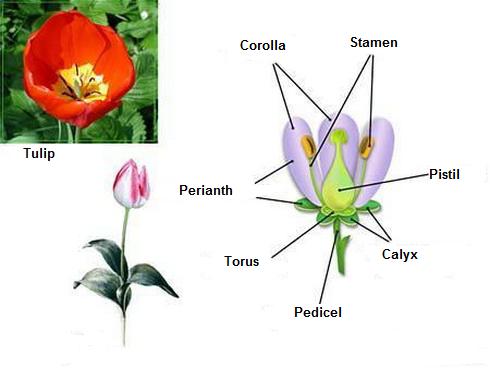|

Flowers are organs of sexual reproduction produced by the angiosperms (phylum anthophyta), the largest phylum of photosynthetic organisms, with roughly 250,000 species. This large number represents a great diversity of flower types, but all flowers have some common structural elements.
Flower Parts
Flowers are modified shoots bearing modified leaves. In the typical flower, the modified leaves can be grouped into four sets based on appearance and function: sepals, petals, stamens, and pistils. The sepals and petals are lowermost on the shoot toward the sides of the flower. The stamens and pistils are at the tip of the shoot at the inside. While sepals and petals are easy to see, stamens and pistils are often visible only when the flower is closely examined. Two other important parts are the pedicel, a stalk on which flowers are frequently borne, and the top of the pedicel, called the receptacle, to which the other flower parts are typically attached.
Of the four main parts, the sepals are generally the most leaf like and generally are attached to the bottom of the receptacle. Sepals protect the immature flower during the bud stage. Flowers typically have three to eight sepals, depending on the species. Collectively, the sepals in a flower are called the calyx. Above the sepals are the petals. Although flattened like the sepal, each petal is usually soft and colored white, yellow, pink, blue, purple, orange, maroon, or even brown. Petals attract insects, hummingbirds, bats, or other animals, aiding the reproductive process. Usually, the number of petals in a flower will be the same as the number of sepals. Collectively, the petals in a flower are called the corolla.
The stamens, located inside the petals, are composed of a small anther (ball-shaped, egg-shaped, or tubular) and a threadlike filament connecting the anther to the rest of the flower. The anther, in turn, is composed of two or four tiny chambers, within which powdery pollen grains are produced and stored. Each grain of pollen contains the immature sperm of the plant. Thus, the stamens function as the male part of the flower in sexual plant reproduction, and they may number from one to dozens. The term androecium refers collectively to all the stamens within a flower.
The pistils form the final set of parts. Each pistil is often shaped like a vase, although the shape varies. The ovary, the base of the pistil, is swollen and hollow. The wall of the ovary, called the pericarp, is typically green, and the hollow space in the ovary is called the locule. Within the locule are one or more tiny globular ovules, each containing an egg nucleus and thus functioning as the female structure in sexual reproduction. In addition to the ovary, the pistil is typically composed of two or more parts: the style, a slender necklike structure above the ovary, and the stigma, a swollen area at the top of the style that traps pollen grains with minute hairs covered by a sticky, sugary film. While most flowers have only one pistil, many have several pistils, attached to the receptacle. The pistils within a flower are collectively called the gynoecium.
Functions of Flower Parts
Flowers and their parts function to achieve sexual reproduction, including pollination and seed formation.
Continue of the article: Functions of Flower Parts
Structural Variations
Many plant species produce flowers that deviate from the idealized format. Certain lilies, for example, do not have sepals and petals that are clearly distinguishable from each other.
Continue of the article: Structural Variations
|
